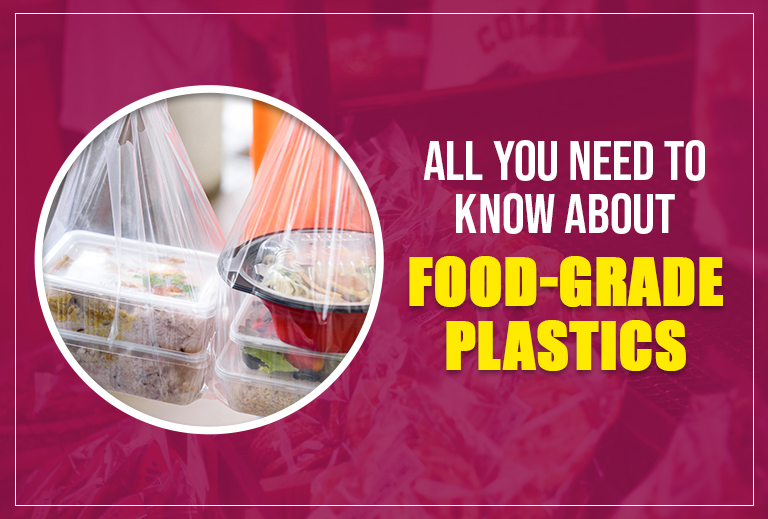All You Need To Know About Food-grade Plastics
Food-grade plastic refers to plastic material certified as safe for food contact. To achieve this designation, plastic must adhere to rigorous standards and undergo more stringent regulation compared to plastic intended for other applications. These specialised plastics are produced with a focus on maintaining a high level of purity. This ensures they are free from dyes or any recycled materials that could potentially jeopardize human health.
The origin of food-grade plastic
Food-grade plastics can be traced back to the early 20th century when the demand for safe and hygienic food packaging materials began to grow rapidly. Before the advent of food-grade plastics, traditional materials like glass, metal, and even paper were commonly used for packaging food items. However, these materials had limitations in terms of weight, cost, and breakability.
The breakthrough came with the development of synthetic polymers such as polyethylene and polypropylene in the mid-20th century, which were found to be non-toxic and resistant to moisture and chemicals. This led to the creation of plastics specifically designed for food contact. This ushered in a new era of food packaging that offered improved safety, convenience, and versatility. Today, food-grade plastics are indispensable in the food industry, ensuring the preservation and distribution of food products worldwide.
Why is food-grade plastic important?
Certain highly acidic foods and alcoholic beverages can occasionally cause plastic additives to migrate from the container or packaging into the contents, potentially leading to human consumption of these additives. Food-grade plastics, characterized by their exceptional purity, effectively mitigate this concern. Consequently, food-grade products offer a safe and reliable solution for storing a wide range of food and beverage items without the risk of additive contamination.
Examples of food-grade plastics
Using non-food-grade plastics to store consumables can pose significant health risks. Some notable examples of food-grade plastics include natural grade Nylon 6 & 6.6, Acetal, UHMWPE, Polypropylene, Polyester (PET), PVDF, PEEKPTFE, and Polyethylene in grade 300 – 500.
Conversely, certain materials, including Nylons with additives like oilon or Mos2, PVC, Polystyrene, Regen (recycled) UHMWPE, and others like Polycarbonate and acrylic, cannot be utilised as food-grade plastics due to their chemical composition.
Where are food-grade plastics used?
Food-grade plastics find widespread use in various applications across the food and beverage industry due to their safety, durability, and versatility. Some common applications include food packaging, food containers, bottles and beverage containers, food processing equipment, food transport and utensils.
The manufacturing of food-grade plastics
Food-grade plastics are manufactured through a specific process that involves selecting appropriate raw materials, ensuring strict quality control, and adhering to regulatory standards. The selected raw materials are subjected to a polymerization process, where they are chemically transformed into long chains of polymers. This process involves heating and pressure and may include the addition of catalysts or other chemicals to control the properties of the plastic.
Food-grade plastics may require the addition of specific additives to enhance their performance and safety. These additives can include stabilizers, antioxidants, colorants and antimicrobial agents to prevent bacterial growth. The polymerized material is then processed through extrusion or injection moulding machines to shape it into the desired form, such as sheets, films, bottles, containers, or other packaging materials.
Finally, food-grade plastics undergo rigorous testing to ensure they do not leach harmful chemicals or contaminants into food. This includes tests for migration, chemical resistance, and thermal stability.
Want to know more about food-grade plastics? Get acquainted with the latest trends in the plastic industry by being part of Plastivision 2023. This prestigious event will be held at the Bombay Exhibition Centre, Mumbai from December 7-11. Count on this event to network with industry peers and leaders. Contact the Plastivision team at 022 6777 8842/46/48 or sanjeevani@plastivision.org to get started. We look forward to hearing from you soon!
Leave a Reply Cancel reply
Recent Posts
- Understanding The Materials That Are Used To Build Plastic Toys
- All You Need To Know About Food-grade Plastics
- A Glance At The Materials That Boost The Performance Of Plastics
- Understanding The Importance Of Exploring New Business Opportunities In The Plastic Industry
- Understanding The Importance Of Investing in R&D For The Plastic Industry
Categories
- 3D Printing
- AIPMA
- Automation
- Automobile Sector
- Bio Plastics
- Environment
- Innovations In Recycling
- Latest Innovations
- Molds & Dies
- News
- Packaging Industry
- Plastic
- Plastic Application
- Plastic Industry
- Plastic Market
- Plastic Myths
- Plastic News From The World
- Plastic Packaging
- Plastic Products
- Plastic Recycling
- Plastic Solar Cells
- Plastic Toys
- Plastic Waste
- Plastic World
- Plastics
- Plastics And Their Applications
- Plastics In Agriculture
- Plastics In Healthcare
- Plastics In Medical Industry
- Plasticulture
- Processing Machinery
- Recycling Machines
- Robotics
- Uncategorized
- Virtual Reality
Archives
- November 2023 (3)
- October 2023 (2)
- September 2023 (3)
- August 2023 (3)
- July 2023 (3)
- June 2023 (3)
- May 2023 (2)
- April 2023 (2)
- March 2023 (2)
- February 2023 (2)
- January 2023 (2)
- December 2022 (3)
- November 2022 (1)
- October 2022 (1)
- September 2022 (2)
- August 2022 (1)
- July 2022 (3)
- May 2022 (3)
- March 2022 (2)
- February 2022 (1)
- January 2022 (1)
- September 2021 (2)
- August 2021 (3)
- July 2021 (4)
- June 2021 (4)
- May 2021 (3)
- April 2021 (2)
- March 2021 (4)
- November 2019 (8)
- October 2019 (8)
- September 2019 (8)
- August 2019 (8)
- July 2019 (8)
- June 2019 (8)
- May 2019 (8)
- April 2019 (8)
- March 2019 (8)
- February 2019 (11)
- January 2019 (8)
- December 2018 (8)
- November 2018 (12)
- October 2018 (12)

